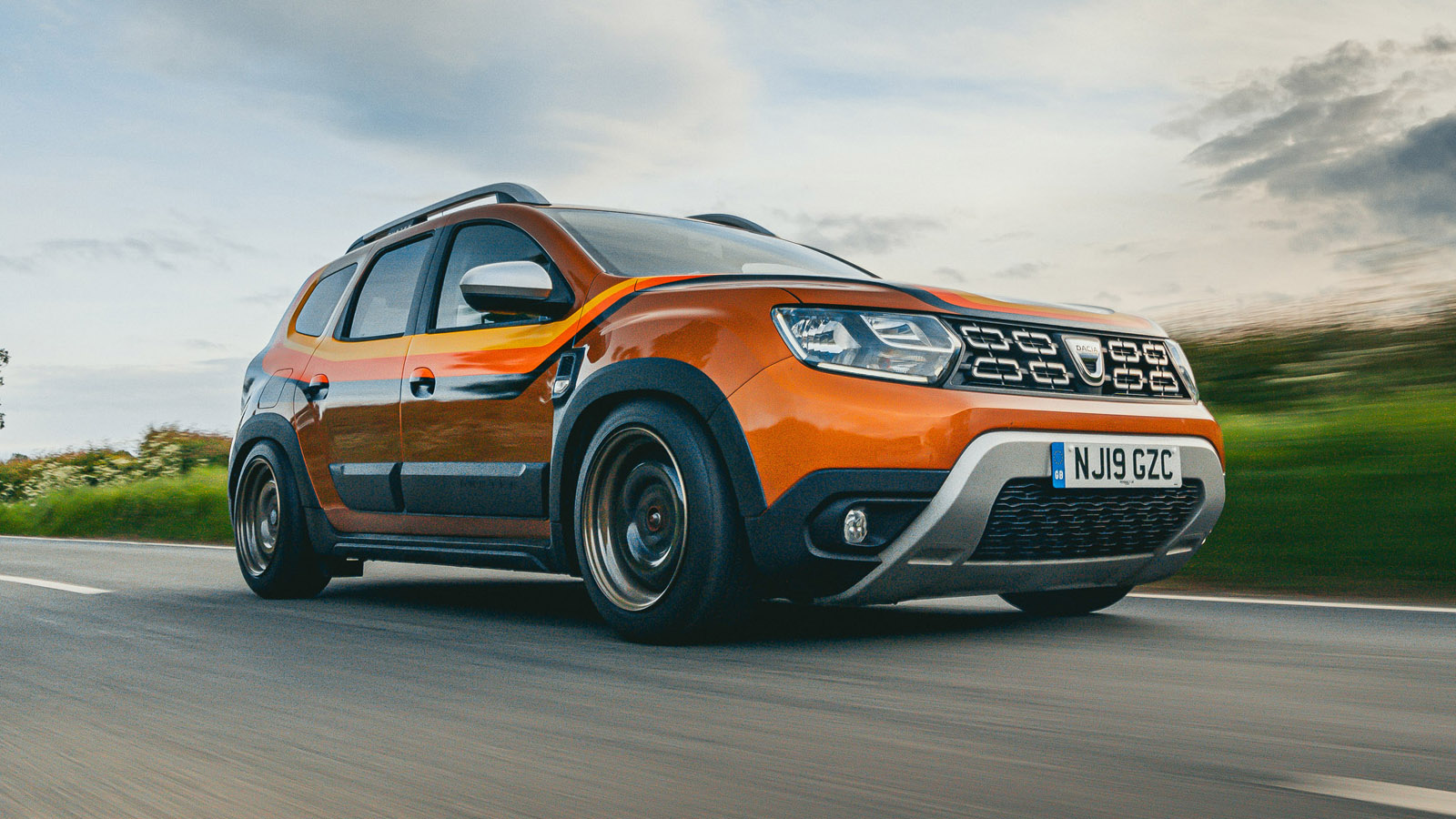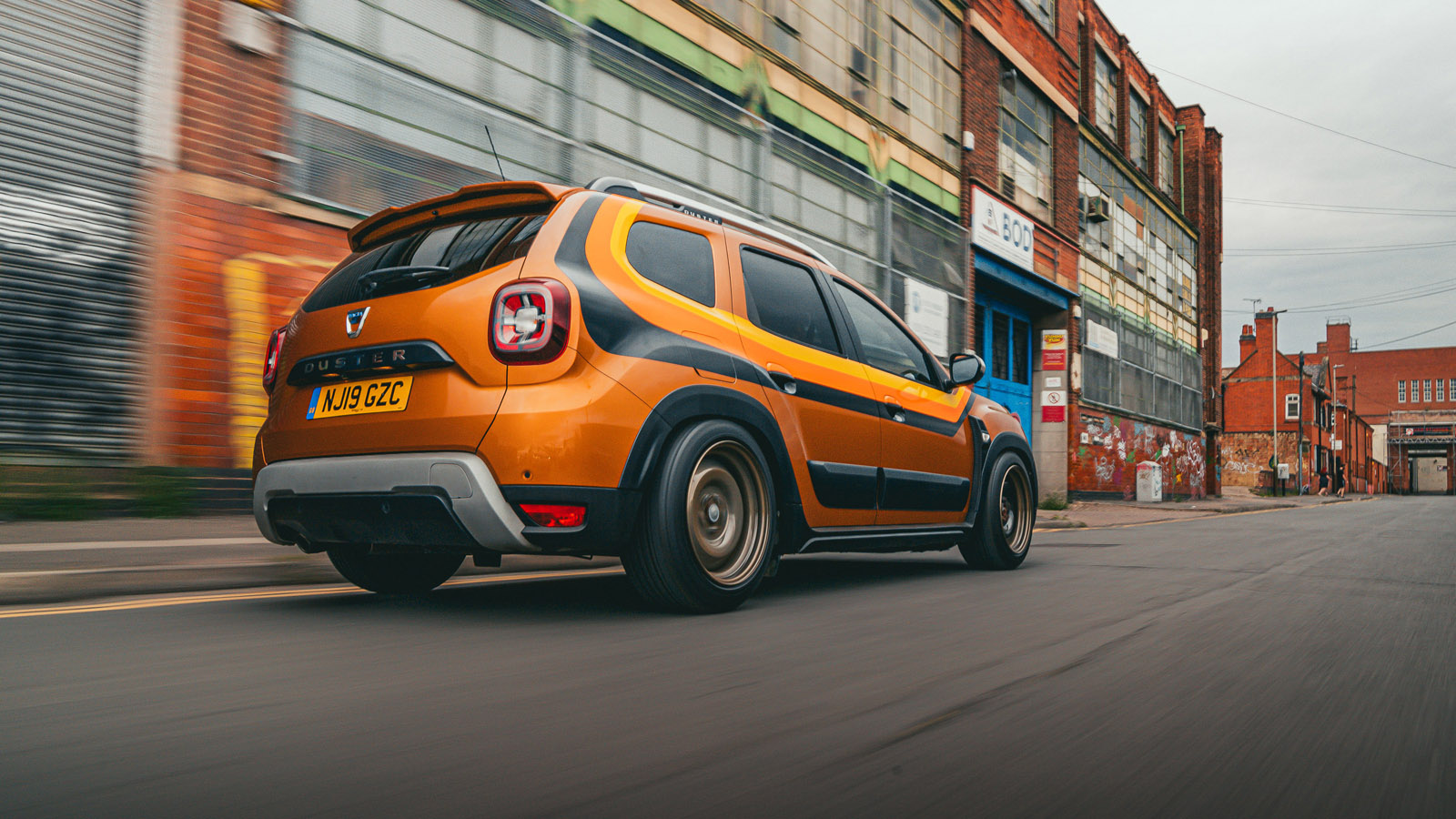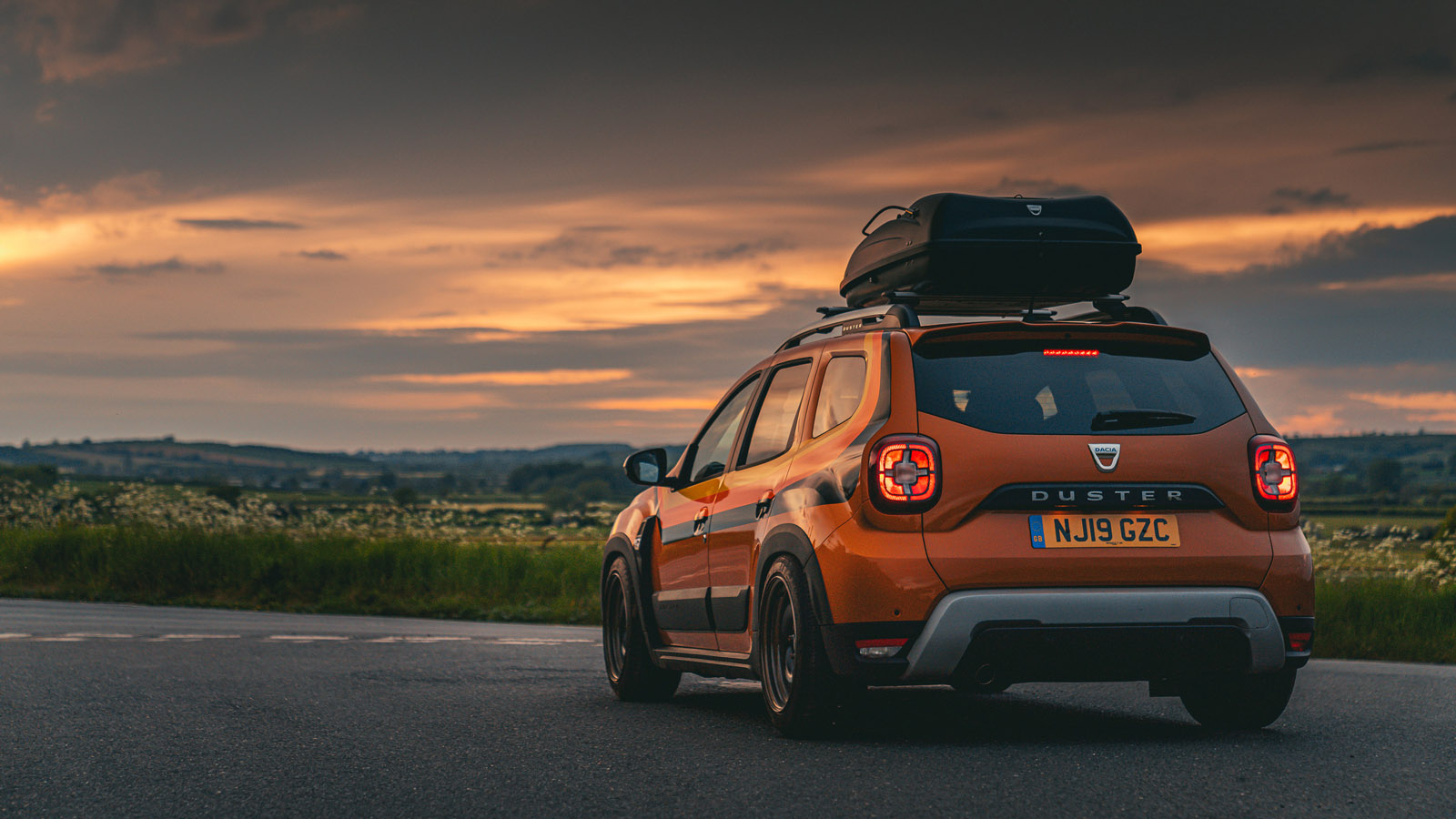
SPEC HIGHLIGHTS
- SPEC
Dacia Duster TCe 130
- ENGINE
1333cc
- BHP
130bhp
- MPG
47mpg
- 0-62
11.1s
Meet the Knuckle Duster
Yes, we may have said goodbye to the Duster. But that wasn't the end of its story...
Being a fan of fitness for purpose means that sometimes you have to forgo style for substance, allow function precedence over form. And although the Dacia Duster is by no means a bad-looking small SUV, it isn’t, it has to be said, something you double take. In fact, it’s one of those cars that’s so remarkably unremarkable that it would be one of my first choices if I were an assassin, bank robber or CID undercover operative. That or a silver VW Golf.
That’s not actually a very good reason to buy one - unless of course, you actually are a bank-robbing assassin - but the Duster has plenty going for it. There’s the fact that, for its size, it is actually very cheap new. Cheap to insure, cheap to run, cheap to fix. I know, practical isn’t very sexy, but you get the idea. In fact, having run one for a good few months, I came to regard it in the same way as lots of other useful-but-unfashionable cars - respectable and practical, but not something that would necessarily provoke the covetous look back every time you walked away from it.
That theme continued in various conversations had throughout the time I ran the car. People - from all walks of life - would ask about the Duster. Is it actually made of crisp packets? Can it handle the motorway? Are they really that cheap new, or is the poverty-spec base version crafted from cardboard and have non-specific holes in it? And the one thing that always seemed to come up was that it was appealing because it was practical, honest and value-for-money, rather than desirable for its own sake. Sensible couture. The Tao of pragmatism.
Fit for purpose(s), but not ‘cool’. Which, after a few months, started to sound very much like a challenge. I, by all accounts, need to get a hobby.
Yeah, I know… it also sounds like a hiding to nothing, but with a fondness for quirky and doing things other people haven’t done, I started looking at my options. Unfortunately, most of the time, the reason things haven’t been done before is that they aren’t worth doing. And yet… the Duster deserved a sprinkle of special, and I could taste the possibilities. Possibilities that mainly involved having a good look at the suspension set up with my mate Ben from String Theory Garage (also an inveterate car-meddler - except he knows what he’s doing) and realising that one of the Duster’s economic strengths - its simplicity - actually allowed for some creative applications in terms of suspension.
Of course, ours is a two-wheel-drive variant in ‘Comfort’ spec, so resolutely on the cheaper end of the spectrum, but with the really rather useful 1.3-litre turbo four-cylinder with 130bhp. A brilliant little engine shared across several manufacturers, including Mercedes (A-Class), Renault (Kadjar) and Nissan (Qashqai). That makes the Duster perfectly capable of getting down the road, thanks to a surprisingly svelte kerb weight of 1,234kg. It’s single-axle drive also makes it rather less complex underneath, offering a simple beam axle in the rear, McPherson-type links on the front and single-tube damping all round. The 4x4 version has McPherson-style multi-link suspension at either end, plus extra driveshafts and other associated gubbins, so is a little bit different. Different is worse, in this context, because complexity generally equals expense - something we wanted to avoid.
Now, a lot of people would be expecting at this point that I would immediately lift the Duster, stick on some big tyres and a lightbar, roof rack the hell out of it and make a cheap Dakar-lite. But that seemed… too obvious. It also seemed a bit weird when the car only drove the front wheels, meaning it would be a bit rubbish off-road anyway. So I decided, looking at the spec - it’s essentially a tall hatchback - to go low, and try and make this tall, unsporting, lifted hatch handle a little bit. But also like, low-low. ‘Stance’ low. ‘Annoy people’ low. Provoke the kind of comments that start with ‘you’ve ruined that’… You think I’m kidding - that was the first thing Top Gear’s Galactic Overlord Charlie Turner said when he saw it.
Still, add in some interesting wheels, some other sprinkles, and you’d have a genuinely eye-widening looking thing, with a bit more dynamic ability than the kinetic vanilla that is the standard Duster. It is wise to point out here that I always thought this would turn out to be a cool car. Not many other people shared my optimism, and more than a few asked the very simple question ‘why?’. To which the inevitable answer was always, obviously, ‘why not?’. Or possibly ‘I don’t know, either’.
I did, however, have some self-made rules in place for the tweaking. There would be no point in calling in favours from all and sundry and racking up a £14k car with £13k of modifications, then trying to say that you found free labour and billet parts under the back seat. So everything had to be paid for, even if I managed mate’s rates. The budget would be £3,500 all-in, roughly a quarter of the purchase price. Sounds a lot, but doing this in stages wouldn’t be that cost-prohibitive, and I’ve seen projects that throw way more money into a car over time.
So. A quick bit of measuring by Ben, a few phone calls by me, and the project was underway. First up, a call to Dave at the Mission Motorsport Livery Department, and we cooked up an idea for a set of vinyl stripes. I’ve always had a slight thing for 1970’s vans and their murals and gaudy flagging, so this seemed an apposite moment to indulge. Dave popped over with some colour swatches, found the Duster’s blueprints online and then came up with a proper rendering of my indecipherable and incredibly vague hand drawn design - based loosely on a myriad of ‘70s vanning legends and the Ford Econoline Cruising Van and Pinto Cruising Wagon of the same era.
Thank God for talented friends. Dave then created a masterful re-working of said design in yellow, orange and black, making the Duster look bizarrely like a pro-German training shoe. Build-tip: a price (£400+VAT) was agreed early when Dave was enthusiastic and slightly vulnerable - I’d fed him several coffees - so when it came to making the stripes fit the Duster’s surprisingly complex curves, I had the young man over a pre-arranged price barrel. Sorry, not sorry, Dave. But thanks.
It is wise to point out here that I always thought this would turn out to be a cool car. Not many other people shared my optimism
I then decided to fit a set of steel wheels, because steel wheels look good on pretty much anything, and chime with the Duster’s utilitarian aesthetic. I could have gone for the obvious - and cheaper option - of standard Dacia steels, but wanted something a bit fancier. For which I approached Weller Wheels - a UK company specialising in fully built steel wheels. I secured a mate’s rate of £250 per wheel, and ordered a set of 17s, with a wider 9.5-inch girth and lacquered over the raw steel rather than painted. Weller did some measuring, figured out the stud pattern for the Dacia’s hubs and had an educated guess as to offsets and depth of dish.
There was measuring and technical conversations that I didn’t understand but nodded along to anyway. Then it was off to manufacture - this being a built wide steel wheel rather than a banded (a halved, widened and re-welded rim). The idea being that they should be naturally stronger/more robust with fewer possible points of weakness. To be honest, I had no idea if they’d actually really fit, other than that I knew the Duster’s arches were cavernous. This was, perhaps, unwise. Still, with enthusiasm still running high, it was back off to String Theory to delete some air gap while the rims were being made.
Hats off, Ben earned his money on this one. Poring over specifications and various measurements, he had concluded that the Duster was essentially ripe for simply grafting on the springs and dampers from a generic hot hatch. Except that any hot hatch has substantially better/lower suspension than the Duster. An Eibach RS fast road kit designed for a mk7 Ford Fiesta was duly dispatched and fitted, and, after much fettling, dropped the Duster so far into the floor the wheels wouldn’t move. Ah.
Still, Ben adjusted and fettled, shimmed and wound out, and the little Dacia started to look like a thing. After the plastic lip of the black bolt-on arches was sympathetically trimmed, the wheels didn’t rub and nothing squeaked. I’ve made this sound much easier than it was, because while the parts bolted on, getting everything set up properly took some time. The car carries some adjustable bolts from a drift car, for instance – to keep the geometry in the right places for the driveshafts – the idea being that this Dacia shouldn’t feel like you have to compromise too much to drive it completely normally.
And it now handled like… well, like a slightly top-heavy hot hatch with modest power. Seriously. A very reasonable £1,500 of parts and labour for Ben and the Eibach kit, and we had a slammed-ish SUV that looked slightly mental and drove roughly five times better than standard - mainly due to the more expensive damping and extra body control. It also made people stand and stare - especially the younger crowd. I think most people actually couldn’t work out what it was, simply because it doesn’t look particularly wrong. And that, I think, is good modifying.
On went the rather gorgeous, flat-faced steel Weller wheels - which required more fettling and some Dremel-based pinching of the plastic stick-on arches (again) - and the Duster looked like a real-life Hot Wheels car. Full disclosure here: I’d completely forgotten to budget for tyres, thinking I could re-use the 215/65 R16s, but then had chosen 17-inch wheels. Duh. So I had to beg some rather useful Nankangs for free, stretching the tyre slightly to give it a bulbous look that seems to fit the aesthetic I was going for. Mind you, if it were my car, I’d be able to sell the still as new taken off bits (wheels and tyres, springs/dampers) to release some funds back into the project.
As a final flourish, I had my friend Ralph (of Ralph Hosier Engineering) build a customised roof box. Now, the original idea was to create a roof box with a rally pod on the front, powered by a solar panel on the top of the ‘box and a bike battery and management module on the inside for what remained of the budget.
Ralph got creative and installed a motorcycle main lamp and some bike spots that I had lying about the garage, and made it all work, Frenching the lights as far as possible into the tough ABS plastic of the roof coffin. It certainly creates an impression - mainly ‘WTF?!’ - but truth be told I’m not totally sold on the way it works with the Duster. It’s a top job, but maybe if I had time to make the roof box sit flush on the roof of the car as I wanted to (instead of up high on the roof rails), it might look more integrated.
Say what you like though, you can’t miss this Duster now. And it came in around budget, if you allow me the comfort zone of sold-on spares. It also could be made even cheaper. Think about it; a decent used Duster from the previous generation weighs in at about four grand. Buy it, drive it, use it. Throw on some suspension and use the standard steels - or whatever floats your boat - and you’d have a genuinely interesting car for around just over six grand. A car that is still practical and cheap, just with a little added extra spice.
But the big question remains, and only the great TG gestalt can answer it: have we made a Dacia Duster cool, or ruined it? Answers on a digital postcard, please…
Images: Mark Riccioni
Featured

Trending this week
- Car Review
BMW 1 Series






